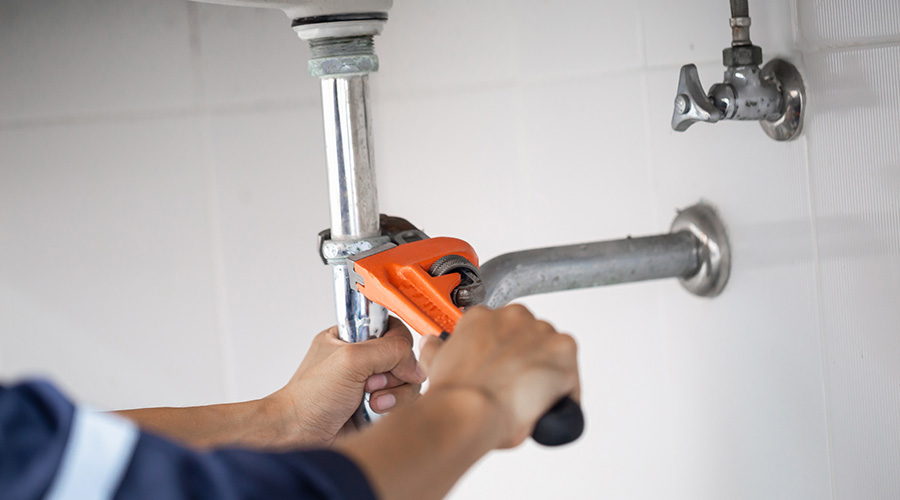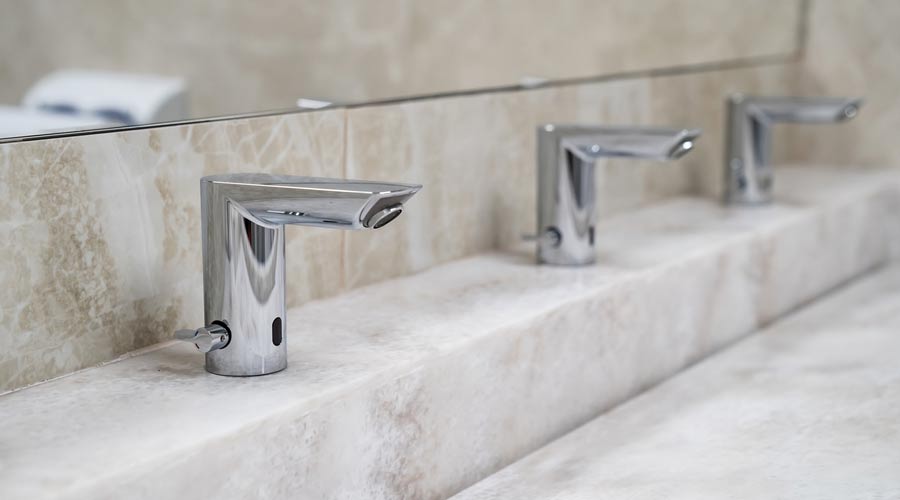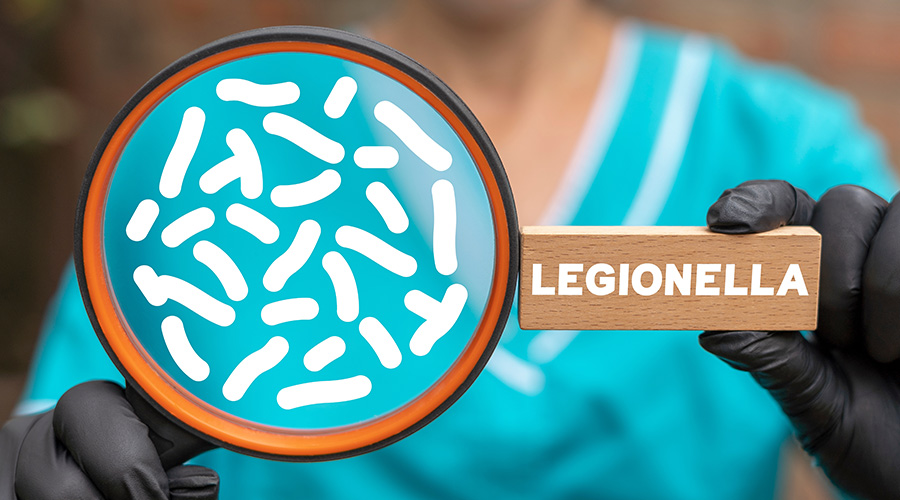Restrooms: Innovation Update
A variety of products introduced over the last few years offers new choices to facility executives interested in better restroom performance.
By Brandon Lorenz, Senior Editor
Design clearly plays a role in establishing the usability and function of any restroom. A restroom that is too small or doesn’t take heavy traffic into consideration, for example, will leave building occupants frustrated.
But if the design is solid, the details can make the difference between a positive or negative restroom experience for many building occupants. A range of recently released restroom technologies gives facility executives a variety of options when approaching restroom design, including the ability to improve a building’s sustainability, protect hygiene, or reduce operating costs.
One example of innovation is the way electronic restroom devices are powered. Manufacturers now offer products that use photovoltaics, fuel cells and turbines to make electricity.
“The green building movement is driving a lot of innovation in the marketplace right now,” says Nate Kogler, product manager for Bradley.
One example is a system that uses a photovoltaic cell to power the infrared sensors and valves in the lavatory.
Introduced in late 2004, Bradley’s ndite technology is available as a retrofit option or on the company’s SS and MG lavatory systems. The photovoltaic cells require about 400 lx of lighting to stay charged, about equal to a brightly lit office space, and are encased in a transparent material to reduce the potential for vandalism.
The photovoltaic cell is designed to store enough energy to allow use in restrooms with occupancy sensors, provided the lights remain on for an average of 10 minutes once they are activated. Rather than use a battery that would need replacement, the system uses a proprietary power module to store energy. The power module is designed to last 15 years, Kogler says.
Sloan’s Solis Faucet also uses a photovoltaic cell to generate electricity. The photovoltaic cell generates electricity from artificial or natural light, and uses a 6-volt lithium battery to power the solenoid in the faucet. The faucet mounts above deck, with options for a mixed supply or separate hot and cold water supply lines.
The company is also using passive sensing technology to increase battery life by reducing infrared sensor use. Rather than relying on always-on active infrared sensors, the faucets incorporate a passive infrared sensor to detect whether the restroom is occupied. Once the passive sensor detects occupancy, the active infrared sensor is activated, allowing the faucet to dispense water when approached by a user.
Assuming a faucet is cycled 3,000 times a month, the batteries can last up to six years with the new passive sensor, says Don Yerkovich, Midwest specification manager for Sloan. Traditional faucets with an active sensor typically last about three years, Yerkovich says.
Other power sources
A fuel cell eliminates the need for batteries in a new air freshener from Technical Concepts. Released in October, the Tcell air freshener relies on technology similar to that used in the medical industry to dispense exact doses of medication over a long period of time. Instead of a battery, a small hydrogen fuel cell is used to force fragrance out of the air freshener’s cartridge on a continuous basis.
The design means that propellants and VOCs do not need to be added to the cartridge, says Jerry McDermott, executive vice president, marketing and product development. Cartridges are designed to last for 60 days, with the fuel cell and fragrance cartridge integrated as a single replaceable unit.
The perception of cleanliness can be a major factor in occupant satisfaction, says McDermott. Occupants will quickly notice if a restroom’s atmosphere is unpleasant and associate the odor with an unhygienic facility, he says.
Miniature hydroelectric turbines power the Ecopower line from TOTO USA. The turbines allow sensor-activated faucets to be retrofitted into restrooms without external electrical power or frequent external battery changes.
The turbine is turned by running water, charging the power supply of the faucets. The faucets also include a backup battery.
The Ecopower system is available in single supply or thermal mixing faucets, and in gooseneck or standard faucet designs. A low-flow version of the faucet is rated at .09 gallons per 10-second cycle, while the standard version is rated at .25 gallons per 10-second cycle. Ecopower technology is also available on the company’s flush valves, says Lenora Campos, public relations manager.
Hygiene a focus
Incorporating products that can improve restroom hygiene remains a key part of restroom design.
“What we are seeing is a continual push towards making everything touchless,” says Tom Banks, director of marketing communications for Georgia-Pacific. “Where you can’t make something totally touchless, you want to at least help people avoid touching things with their hands.”
Released in 2002, the company’s enmotion touchless roll towel dispenser is powered by four D batteries. A hand motion activates the sensor with the system dispensing a single towel, while a delay mechanism prevents the dispenser from repeatedly dispensing towels when a user is standing in front of the unit.
The distance required for activation is adjustable. That means facility executives with smaller restrooms can set a shorter distance to reduce false sensor activation. Towel length can be adjusted as well. The dispensers can also be set to “hang mode,” a setting intended for high-use facilities such as movie theaters or stadiums, where a towel is dispensed and hangs out of the unit as soon as one is removed.
The dispenser is available in a blue or gray wall-mount unit, or in a new stainless steel recessed version, which is aimed at providing roll towel dispensing for restrooms in Class A office facilities.
A touchless soap dispenser from World Dryer is meant to enhance hand sanitation while conserving soap. The units use an infrared sensor to automatically dispense 1.5 cc of soap from a 24-ounce reservoir when activated. The sensor has a range of three to six inches and uses 4 AA batteries, which last an average of two years, according to the company.
The dispensers are available in white or chrome finishes.
The OptiServ dispenser from Wausau Paper/Bay West aims to control costs by reducing paper towel use and improving hygiene. The dispenser holds an 800-foot roll of towels, along with a 4-inch stub roll. The dispenser measures and cuts an 11-inch towel with each pull.
The unit is designed so that users only touch the towel they use. It is available in five translucent colors that coordinate with the company’s existing Silhouette line of dispensers.
Cost control
While products meant to safeguard the hygiene of occupants remain important, new technology that can control operating costs or improve the user experience in restrooms has also been introduced.
The Commander system from Chicago Faucets is designed to allow maintenance employees with hand-held Palms to interface with the company’s Galileo series of electronic faucets or Geberit’s electronic flush valves, says Suzanne Shaw, director of marketing and customer service, sales and marketing for Chicago Faucets.
The software functions with Palm OS 3.5 or higher, and allows remote adjustments in the sensing range, water metering modes, and time delay in the faucets. The software can also display usage history, unit and battery status, replacement part numbers and contact information.
The company is expecting to add the Palm capability to additional faucets this summer, including a line that would be mounted entirely above deck, Shaw says.
Reducing graffiti is the goal of the Sierra series line of toilet partitions from Bobrick. Introduced in 2004, the partitions evolved from the company’s line of solid phenolic toilet partitions. The line is intended for schools, airports or other areas that see intense use, says Alan Gettleman, director of marketing for Bobrick.
“The most important thing is to pick a material that works for the needs of the building,” Gettleman says. “That involves not only the partition material, but also the hardware.”
Schools, for example, have unsupervised restrooms that are subject to brief but intense use throughout the day during classroom breaks. Such a facility requires highly vandal-resistant partitions, unlike an office building, which is home to the same employees for years.
The solid reinforced color toilet partitions are made from dyed organic fibers reinforced with polycarbonate and phenolic resins. The partitions have a Class B fire rating, and are designed to be harder than plastic to improve graffiti resistance. The homogenous material has color all the way through the partition, with four colors available — golden khaki, desert beige, terra cotta and forest green.
The color selection includes only earth tones because the partitions are partially composed of wood fiber, which limits how much the material can be bleached and pigmented, says Gettleman.
Simplifying operations
A new, simplified drain mechanism from American Standard is designed to improve the function of drains in health care and hotel applications, which often use popup-style drains.
“One of the trends we’ve noticed is the desire for technology that can save time and money from the facility management side and keep consumers happier,” says Michele Hudec, senior marketing director for fittings and commercial products for American Standard.
The company’s Speedconnect drain reduces from 14 to four the number of parts that need to be installed in a drain. The new system uses a cable and cam system, with the mechanism traveling along a fixed cable, a revision that is intended to reduce the need for adjustment once the drain is installed. While traditional popup systems may require three inches of travel to activate the mechanism, the company’s new design requires 5/8 of an inch. The new mechanism also speeds installation because there are fewer parts to contend with, Hudec says.
The desire to reduce restroom changeouts led Kimberly-Clark Professional to release its Scott jumbo rolls as coreless tissue in 2003, a move that followed the company’s release of coreless single rolls in 2001.
The goal of the design was to reduce the number of cores that needed to be disposed of in the restroom, says Richard Thorne, strategic business unit leader, Kimberly-Clark Professional North American Washroom Business. Filling in the core with paper allowed the company to add 15 percent more tissue to the jumbo roll.
Released last year, a new coupler from Falcon Waterfree aims to simplify installation of the company’s waterless urinals in retrofit applications. “Facility executives are looking for reliability and durability,” says Bill Stimer, director of customer experience. “Typically a facility executive’s hair is on fire at least once a day because something in the building isn’t working.”
The unicoupler II is meant to solve a common problem — many of the drain systems in existing waste systems have a flat horizontal connection to the urinal. With traditional systems, that isn’t an issue. But with a gravity-fed waterless urinal, a pitch of a 1/4-inch per foot is typically required to make the systems operate properly, says Stimer. The flexible coupler includes an extension pipe that overcomes the pitch, allowing the unit to drain properly even if the existing pitch of the drain has not been altered, Stimer says.
Related Topics:











